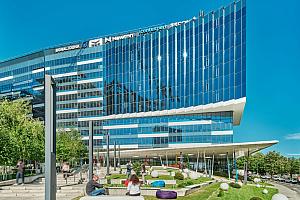Cushman & Wakefield Echinox: Bucharest office market sees demand slowdown, but signs of recovery ahead

The Bucharest office market recorded a significant drop in leasing activity during the first quarter of the year, with gross take-up reaching 51,300 square meters - down 44% compared to Q1 2024, according to data from Cushman & Wakefield Echinox. Despite this slowdown, the market is showing early signs of recovery, with a series of major transactions expected to close in the second half of 2025.
Net take-up accounted for 64% of total demand in Q1, marking the highest share since early 2022, according to the same report.
The office space demand also slowed down in Q1 across Central and Eastern Europe (CEE), where less than 30,000 sqm were delivered across the region. The total take-up in CEE was of approximately 500,000 sqm, corresponding to a q-o-q decrease of 40%, and a y-o-y decline of 2%.
Meanwhile, the vacancy rate in Bucharest dropped to 13.6%, the lowest level since the second quarter of 2021. This downward trend is projected to continue throughout the year, as no new medium or large-scale office buildings are set to be completed in 2025.
The highest vacancy rates in the region are in Sofia (14.6%), Bratislava (14.6%), and Budapest (14.1%). Prague has the lowest vacancy rate (7.0%), while 10.5% of the Warsaw office stock is vacant.
Bucharest currently has 132,300 square meters of office space under construction, most of which is scheduled for delivery between 2026 and 2027. This represents roughly 11% of the total development pipeline across capital cities in Central and Eastern Europe (CEE), which collectively have around 1.19 million square meters underway.
While developers in Budapest lead the regional market with 472,000 square meters under construction - primarily for owner-occupied public and financial institutions - Bucharest remains relatively modest in its new supply. Still, upcoming projects are expected to help balance demand and improve market conditions in the coming years, Cushman & Wakefield Echinox said.
Prime rents in Bucharest’s central business district (CBD) remained stable in Q1, ranging between EUR 20 and EUR 21 per square meter per month. In central and semi-central locations, rents hovered between EUR 15 and EUR 18, while peripheral areas recorded monthly rates between EUR 9 and EUR 13.50. A limited rent increase is anticipated by year-end, particularly in landlord-favored areas such as the CBD and central zones, where vacancy rates are especially low.
Despite recent challenges, Bucharest continues to offer some of the most affordable office space among major CEE capitals. Only Sofia and Bratislava have lower headline rents, while Prague tops the list with EUR 30 per square meter per month, followed by Warsaw and Budapest at EUR 25.
irina.marica@romania-insider.com
(Photo source: Andreasg/Dreamstime.com)













